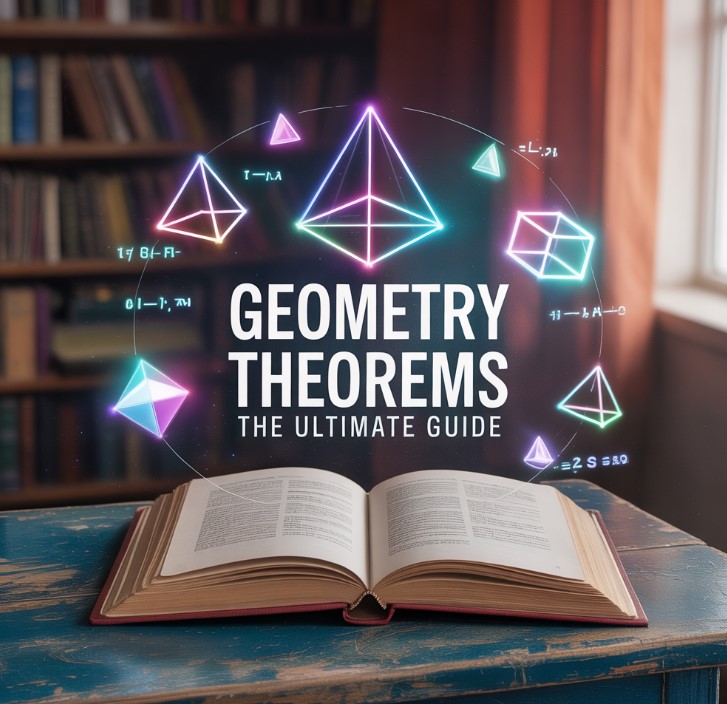Contents
This ultimate guide provides a complete list of basic geometry theorems, offering the essential rules you need for Geometry, from angles to circles, which will empower you to solve any problem you encounter.
Does Geometry feel like learning an entirely secret language? I am here to tell you that it certainly does not have to feel that way! The key to solving problems is understanding the rules of the game. The guiding lights for all of Geometry are Definitions, Geometry Postulates, and the very useful Geometry Theorems. In this comprehensive guide I have created, we’ll explore a complete list of basic geometry theorems, carefully broken down by shape, so you always have the right tool for the job. You will soon see that mastering these concepts is achievable.
The Ground Rules: Definitions, Postulates, and Theorems
To succeed, you first need to understand the fundamental building blocks of geometric logic, which I have laid out below in a simple way. Understanding the difference between postulates and theorems is the first step toward building your confidence.
A. Geometry Definitions: The Vocabulary
These are simply the words we use to name things, like a point, a line segment, or a specific type of angle. For example, a “ray” is a part of a line that has one endpoint and extends infinitely in one direction. I find that mastering Geometry Definitions makes every other part of the subject much easier to understand and apply correctly.
B. Geometry Postulates: The “Set in Stone” Rules
These are specific foundational rules that we accept as true without needing any formal proof because they represent self-evident, common-sense ideas. You cannot argue with them because they are the very basis of our reasoning. A classic example of the many Geometry Postulates is the rule stating that for any two distinct points, there is exactly one straight line that contains them.
C. Geometry Theorems: The Rules We Can Prove
Unlike postulates, theorems are powerful statements that must be proven to be true by using our definitions, postulates, and even other previously proven theorems. For the purpose of this guide, I will focus on what the theorems are so you can apply them to solve problems effectively. The key to solving problems is understanding the rules of the game.
Angle Theorems: Rules for Intersecting and Parallel Lines
When lines intersect or run parallel to each other, they create angles that have very special and predictable relationships with one another. These essential Angle Theorems are your guide to understanding and calculating those relationships accurately.
A useful set of rules comes from the interaction of Parallel Lines with a third line, called a transversal, that cuts across them.
| Theorem Name | Description | Visual Tip |
|---|---|---|
| Vertical Angles Theorem | Angles that are directly opposite each other at an intersection point are always congruent, meaning they have an equal measure. | Look for an ‘X’ shape. The angles on the top and bottom are equal, and the angles on the left and right are equal. |
| Alternate Interior Angles Theorem | These angles are found on opposite sides of the transversal line and are located inside the two parallel lines; they are always congruent. | I tell my students to look for a ‘Z’ shape (or a backwards ‘Z’) to easily spot these congruent angle pairs. |
| Alternate Exterior Angles Theorem | These angles are positioned on opposite sides of the transversal line but are located outside the two parallel lines, and they are also always congruent. | These are the pairs outside the ‘Z’ shape you found earlier; they match in measurement. |
| Same-Side Interior Angles Theorem | These angle pairs are located on the same side of the transversal line and are found inside the parallel lines; they are supplementary, adding up to 180 degrees. | They form a ‘C’ shape. The two angles inside the ‘C’ sum to 180°. |
Here is a diagram illustrating these angle relationships when a transversal intersects two parallel lines.
l1 ───1/2───>
/
t 3/4
/
l2 ───5/6───>
/
7/8- Vertical Angles: ∠1 & ∠4; ∠2 & ∠3; ∠5 & ∠8; ∠7 & ∠6
- Alternate Interior Angles: ∠3 & ∠6; ∠4 & ∠5
- Alternate Exterior Angles: ∠1 & ∠8; ∠2 & ∠7
- Same-Side Interior Angles: ∠3 & ∠5; ∠4 & ∠6
Additionally, I want you to remember these two theorems about complementary and supplementary angles:
- Congruent Complements Theorem: If two angles are complementary to the same angle, then they are congruent to each other.
- Congruent Supplements Theorem: If two angles are supplementary to the same angle, then they are congruent to each other.
Triangle Theorems: Secrets of 3-Sided Shapes
Triangles are one of the most fundamental shapes in all of geometry, appearing constantly in various problems and real-world structures. These powerful Triangle Theorems will help you easily figure out their unknown angles and side lengths.
- The sum of the interior angles of a triangle is 180°, a foundational rule you will use more than any other.
- The exterior angle theorem triangle states that the measure of an exterior angle of a triangle is equal to the sum of the measures of its two opposite interior angles.
- According to the Isosceles Triangle Theorem, the base angles of an isosceles triangle, which are the angles opposite the two congruent sides, are congruent.
- Are you wondering how to prove two triangles are similar so you can compare their properties? I suggest using these simple theorems below!
- Angle-Angle (AA) Similarity: If two angles of one triangle are congruent to two angles of another triangle, then the two triangles are similar.
- Side-Side-Side (SSS) Similarity: If the corresponding side lengths of two triangles are all proportional, then the triangles are similar.
- The Triangle Proportionality Theorem states that if a line divides two sides of a triangle in the same ratio, it is parallel to the third side.
For a helpful visual explanation of these concepts, I recommend this video:
Circle Theorems: Properties of the Perfect Shape
The many Circle Theorems can look intimidating at first, but I assure you they follow a few simple and consistent rules. Here is a clear checklist of what you need to know to solve circle-based geometry problems.
Angle Theorems in Circles
- A critical rule is that the angle at the center is twice the angle at the circumference when both angles are subtended by the same arc.
- The rule for angles in the same segment of a circle states they are always equal to each other.
- The measure of the angle in a semi-circle is 90 degrees every single time, forming a right angle.
Tangent and Chord Theorems
- The angle between tangent and radius at the point of tangency is always a right angle, which measures 90 degrees.
- A key property is that the lengths of tangents from a common point to a circle are always equal.
Quadrilateral Theorem
- I want you to learn the properties of a cyclic quadrilateral, which is a four-sided figure whose vertices all lie on a single circle; its opposite angles are supplementary, meaning they add up to 180°.
Parallelogram Theorems: Tests for Quadrilaterals
How can you be absolutely certain that a given quadrilateral shape is actually a parallelogram? These helpful Parallelogram Theorems are your definitive checklist. If a shape passes just one of the following tests I’ve listed, you can prove it is a parallelogram.
Here are the four tests that will help you learn how to prove a quadrilateral is a parallelogram:
- Test 1: If both pairs of opposite sides of a quadrilateral are congruent, then the figure is a parallelogram.
- Test 2: If both pairs of opposite angles of a quadrilateral are congruent, then you have proven it is a parallelogram.
- Test 3: You can use the properties of parallelogram diagonals to prove its identity, because if the diagonals of a quadrilateral bisect each other, then the shape is a parallelogram.
- Test 4: If just one pair of opposite sides is both parallel and congruent, then the quadrilateral is a parallelogram.
Summary: Your Geometry Toolkit
You now have a powerful toolkit! This list of basic geometry theorems for angles, triangles, circles, and parallelograms gives you the rules you need to solve a huge variety of problems. I highly recommend you keep this guide handy and practice using these theorems on different exercises to build your confidence and skill. Remember, the key to solving problems is understanding the rules of the game.
FAQ: Quick Answers to Common Questions
Q: What is the vertical angles theorem?
A: The simple answer to what is the vertical angles theorem is that angles positioned directly opposite each other when two lines intersect are congruent, which means they are equal in measure.
Q: What is the pythagorean theorem formula?
A: The what is the pythagorean theorem formula question is one I get often; the theorem uses the formula a² + b² = c² for right-angled triangles, where ‘c’ is the hypotenuse, and it helps you find the length of a missing side when you know the other two.
Q: What are congruent angles?
A: The question of what are congruent angles has a very direct answer; they are simply any angles that have the exact same measure when expressed in degrees.





